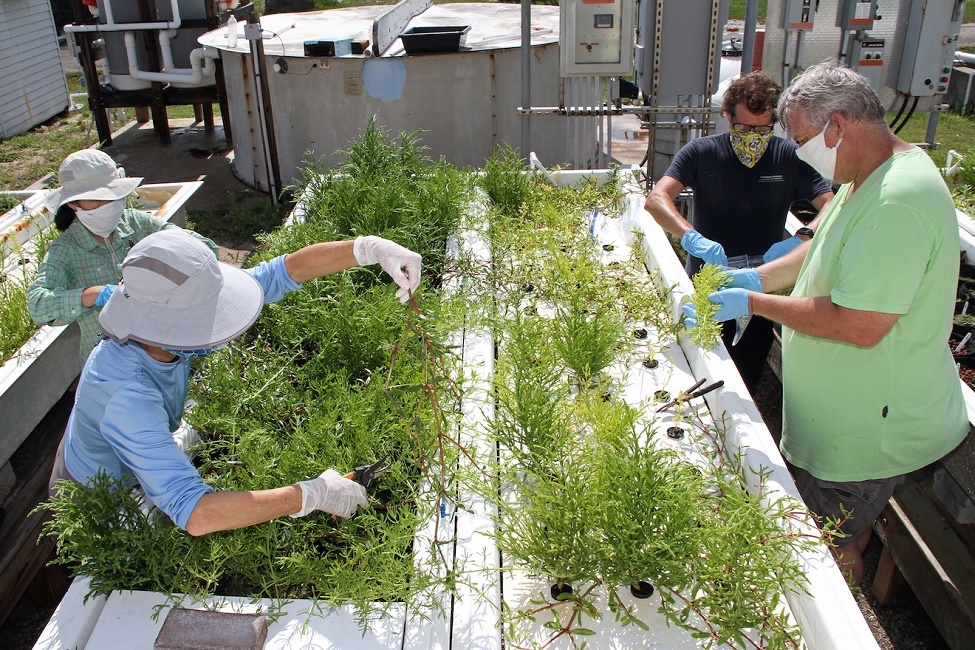Could These ‘Salt-loving’ Edible Sea Vegetables be the New Kale?

The three types of sea vegetables grown by ∞ƒ√≈¡˘∫œ≤ ¿˙ ∑º«¬º‚Äôs Harbor Branch scientists are sea asparagus, which look like regular asparagus, sea purslane leaves that have red on the ends; and saltwort with the smaller leaves. (Photo credit: Megan Davis, Ph.D.)
Skip the salt! Three species of vegetables from the sea could just be the new kale with the added benefit of a salty flavor. Researchers from ∞ƒ√≈¡˘∫œ≤ ¿˙ ∑º«¬º‚Äôs Harbor Branch Oceanographic Institute recently completed a 10-week study to determine the optimal growing conditions for three species of sea vegetables: sea asparagus (Salicornia bigelovii), sea purslane (Sesuvium portulacastrum) and saltwort (Batis maritima). These sea vegetables are eaten in Europe, Asia and Hawaii and could soon be a great addition to salads, soups, pasta, rice and other dishes in the continental United States.¬Ý
These nutritious plants for human consumption do not require fresh water and instead are grown in salt water. These sea vegetables are halophyte plants or “salt-loving” plants, which is what gives them their salty flavor. Considered a vegetable, herb or an edible garnish, they are found in nature in the salt marshes and thrive in saltwater with the right balance of nutrients. They can be eaten raw, blanched, sautéed, or cooked in a dish.
The study, which is part of ∞ƒ√≈¡˘∫œ≤ ¿˙ ∑º«¬º‚Äôs Integrated Multi-Trophic Aquaculture system project to optimize sustainability and aquaculture production, has been testing three different substrates to grow the sea vegetables: sand, clay pebbles, and water only. The work is an ambitious system that produces multiple species simultaneously and is designed according to the premise that one ‚Äúspecies‚Äô trash is another one‚Äôs treasure.‚Äù Greater sustainability has been the driver of aquaculture systems development at ∞ƒ√≈¡˘∫œ≤ ¿˙ ∑º«¬º‚Äôs Harbor Branch, leading to advances that have included minimizing both water use through recirculation techniques and power use via improved efficiency.
In this latest study, the largest plant harvested was the saltwort, which was grown in the sand substrate and weighed almost 2 pounds. Approximately 100 pounds of the plants that were grown in the study came from six tanks in the experimental system. By the end of the study, researchers had grown a total of 187 plants, only losing two plants, which demonstrates their exceptional survival. The average edible portion from the plants ranged from 55 percent for the sea purslane to 72 percent for the sea asparagus and 75 percent for the saltwort. The plants did better overall in the sand substrate; were a greener color in the sand and clay treatments; and were lighter green when grown in the water only tanks.
‚ÄúSea vegetables are a great source of minerals and would be a healthy addition to any meal,‚Äù said Paul Wills, Ph.D., principal investigator of the Integrated Multi-Trophic Aquaculture system project, a research professor and associate director for research at ∞ƒ√≈¡˘∫œ≤ ¿˙ ∑º«¬º‚Äôs Harbor Branch, who is working with co-PI , Ph.D., a research professor, aquaculture and stock enhancement at ∞ƒ√≈¡˘∫œ≤ ¿˙ ∑º«¬º‚Äôs Harbor Branch. ‚ÄúWe sent our recently harvested sea vegetables to the lab to be analyzed for proteins, fats, minerals, and carbohydrates. From our previous studies, we know that one serving will provide 1 gram of plant protein, no fat, and no cholesterol. Some varieties of halophyte plants contain iodine, which is an important element for health and the salt that they contain is similar to sea salt.‚Äù¬Ý
The goal of the study is to demonstrate and identify the optimal growth criteria for the plants, determine markets, work with chefs to develop recipes, and understand consumers‚Äô acceptance to the product. Researchers also will determine the economics of growing these plants and the market values. They plan to share this information with future producers to assist them with system technology, product development and marketing to generate a new aquaculture industry in Florida and elsewhere. ¬Ý
Sea vegetables effectively remove nutrients produced from marine fish, shrimp and other species grown in ∞ƒ√≈¡˘∫œ≤ ¿˙ ∑º«¬º‚Äôs Integrated Multi-Trophic Aquaculture system. As the sea vegetables remove nutrients from the water, they in turn yield highly productive and desirable, albeit, underutilized crops. Sea vegetables are started from seeds or from cuttings, grow very quickly and are ready to harvest in 8 to 10 weeks.
The species in this land-based Integrated Multi-Trophic Aquaculture System are fish, shrimp, urchins, oysters and macroalgae, also known as seaweed, and each is grown separately from the others. Connecting them all, however, is a network of filters and piping that enable circulation of the water and, in particular, the “waste” products. Each species represents a different trophic (or feeding) level in this food web construct, and although the fish and shrimp receive feed from outside the system, each subsequent species feeds on something the others leave behind.
Circulation occurs via a hub-and-spokes concept in which the hub is a computer-controlled filtration and distribution system and the spokes lead to the different culture areas. In the prototype system, all components are indoors with the exception of the macroalgae cultures, which require sunlight.
‚ÄúScientists, engineers and aquaculture technicians at ∞ƒ√≈¡˘∫œ≤ ¿˙ ∑º«¬º‚Äôs Harbor Branch Oceanographic Institute carefully coordinated this study during a very challenging time in research due to COVID-19,‚Äù said James Sullivan, Ph.D., executive director of ∞ƒ√≈¡˘∫œ≤ ¿˙ ∑º«¬º‚Äôs Harbor Branch. ‚ÄúTheir efforts have demonstrated the feasibility of successfully growing and harvesting nutritious and delicious sea vegetables using aquaculture while minimizing waste and maximizing efficiency and productivity.‚Äù
The research team includes Jordon Beckler, Ph.D., an assistant research professor; Ikuko Fujisaki-Butler, Ph.D.; Obby Tapley; Richard Mulroy; Richard Baptiste; Matt Quinan; Lynn Wilking; and Brian Cousin, all within ∞ƒ√≈¡˘∫œ≤ ¿˙ ∑º«¬º‚Äôs Harbor Branch.
This project is supported by funds from the Aquaculture Specialty License Plate granted through the Harbor Branch Oceanographic Institute Foundation.

-∞ƒ√≈¡˘∫œ≤ ¿˙ ∑º«¬º-
Tags: research | faculty and staff | harbor branch | science